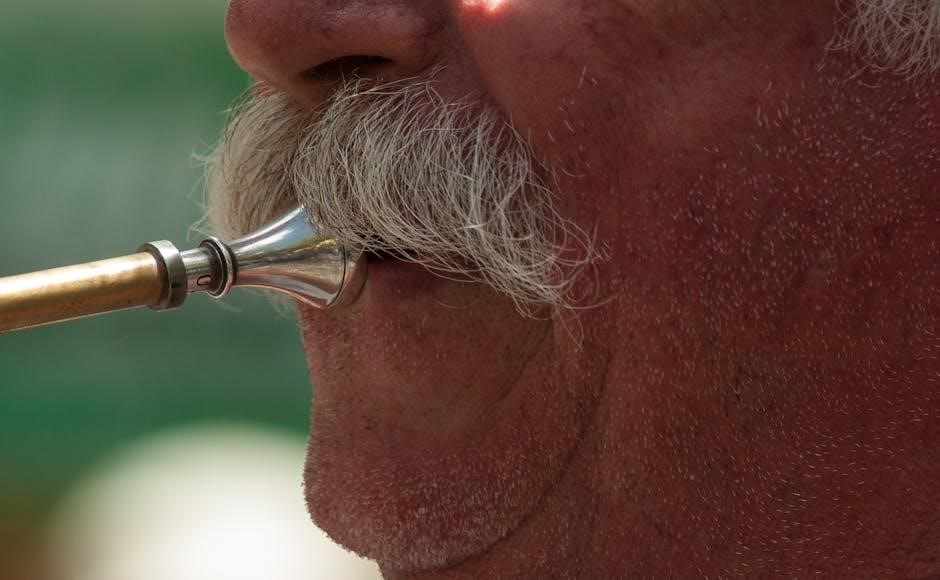
horn mouthpiece guide
The horn mouthpiece is a fundamental component of horn playing, directly influencing tone, pitch, and overall performance. Its design and fit are critical for optimal sound production and player comfort. With various options available, selecting the right mouthpiece is essential for both beginners and advanced musicians. Understanding its role and characteristics is the first step in mastering the instrument.
1.1 Importance of the Mouthpiece in Horn Playing
The mouthpiece is crucial for producing the desired tone, pitch, and dynamic range. It directly affects the player’s comfort and endurance, influencing sound quality and playability. A well-suited mouthpiece enhances musical expression, while an ill-fitting one can hinder performance. Its role as the bridge between the player and the instrument makes it indispensable for achieving optimal results in horn playing.
1.2 Brief History of Horn Mouthpiece Development
The horn mouthpiece has evolved significantly from natural horn mouthpieces to modern designs. Early developments focused on natural materials and simple craftsmanship. The shift to brass and bronze allowed for more durability and consistency. Modern innovations include diverse cup depths, rim shapes, and bore sizes, catering to various playing styles and musical demands, enhancing both sound quality and player comfort.

Understanding Horn Mouthpiece Components
The horn mouthpiece comprises the cup, rim, throat, and backbore, each influencing tone, pitch, and comfort. Materials and design variations cater to different playing styles, enhancing performance.
2.1 Cup Depth and Diameter
The cup depth and diameter significantly impact the horn’s tone and playability. A deeper cup produces a warmer, richer sound, while a shallower cup offers brighter, more agile articulation. The diameter affects comfort and embouchure formation, with larger diameters suiting players with fuller lips and smaller ones favoring precision and control. Proper sizing ensures optimal performance and endurance.
- Cup depth influences tone color and pitch accuracy.
- Diameter affects embouchure comfort and airflow efficiency.
2.2 Rim Shape and Comfort
The rim shape and comfort of a horn mouthpiece are vital for proper embouchure formation and long-term playability. A well-designed rim supports the lips and facial muscles, reducing fatigue. Round rims offer a softer feel, while flat rims provide more precision. Proper fit ensures consistent tone and endurance, making it essential to choose a mouthpiece that aligns with individual anatomical needs.
- Rim shape affects embouchure and playability.
- Comfort is key to preventing fatigue and discomfort.
- Trying different rim styles helps find the best fit.
2.3 Throat and Backbore Design
The throat and backbore of a horn mouthpiece play a crucial role in airflow and tone production. A larger throat allows for greater volume and depth, while a smaller throat provides brighter, more focused sound. The backbore influences resistance and pitch accuracy. Proper sizing and alignment ensure optimal resonance, making these components essential for achieving desired tonal qualities and playability across the instrument’s range.
- Throat size affects airflow and tone quality.
- Backbore design impacts resistance and pitch accuracy.
- Proper alignment enhances resonance and playability.

Choosing the Right Mouthpiece
Selecting the ideal mouthpiece depends on personal preference, playing style, and musical goals. Factors like cup depth, diameter, bore, and backbore significantly impact tone, range, and comfort. Testing different options is crucial to find the best fit for optimal performance.
3.1 Factors to Consider: Tone, Range, and Endurance
When selecting a mouthpiece, prioritize tone quality, playable range, and physical endurance. A larger cup depth enhances low-range tone but may reduce upper-range clarity. Rim shape affects comfort and endurance, while backbore design influences projection. Balancing these factors ensures a mouthpiece that suits both musical demands and personal playing style, fostering consistent performance across all registers.
3.2 Trying Before Buying: The Importance of Testing
Testing a mouthpiece before purchasing is crucial to ensure it suits your playing style and needs. Visit a music store to try different models, focusing on comfort, tone quality, and playability. Play for an extended period to assess endurance and overall feel. What works for others may not work for you, making hands-on testing essential for the best fit.

Tips for Beginners
Start with a mouthpiece that fits comfortably and suits your skill level. Focus on proper embouchure and breath control to develop a consistent sound and technique.
4.1 Starting with the Right Size and Comfort
Beginners should prioritize a mouthpiece that feels comfortable and fits properly. A mouthpiece with a smaller cup diameter and medium depth is often recommended for its ease of playability. Proper fit ensures better control over pitch and tone. Avoid overly large or deep cups, as they can lead to fatigue and discomfort. Testing different sizes is crucial to find the ideal match for your embouchure and breathing technique.
4.2 Adjusting Embouchure for Optimal Sound
Proper embouchure is essential for producing a rich, clear tone. Form a firm yet relaxed position with your lips and facial muscles, ensuring the mouthpiece sits comfortably. The tongue should be placed gently against the roof of the mouth to direct airflow. Practice long tones and lip slurs to build control and consistency. Regular practice strengthens the embouchure, improving pitch accuracy and overall sound quality.

Maintenance and Care
Regular cleaning and sanitizing are crucial for maintaining the mouthpiece’s performance. Use a soft cloth and mild soap to prevent corrosion. Store it in a protective case to preserve its shape and hygiene.
5.1 Cleaning and Sanitizing the Mouthpiece
Cleaning the horn mouthpiece involves using a mild soap solution and a soft-bristle brush to remove residue. Rinse thoroughly with warm water to prevent mineral buildup. Sanitize by soaking in a mixture of equal parts water and white vinegar for 10-15 minutes. Avoid harsh chemicals or abrasive materials that could damage the finish or alter the mouthpiece’s dimensions.
5.2 Storage and Protection
Store the mouthpiece in a protective case to prevent scratches and damage. Avoid extreme temperatures and humidity, as they can warp or corrode the material. Keep the mouthpiece dry and free from moisture to maintain its performance. Handle with care to prevent accidental drops or bends. Regularly inspect for wear and tear to ensure longevity and optimal functionality.

Common Mistakes to Avoid
Overlooking proper fit, neglecting regular maintenance, and using incorrect materials can hinder performance. Ensure the mouthpiece suits your playing style and maintain it diligently for optimal results.
6.1 Overlooking Proper Fit and Comfort
Ignoring the importance of proper fit and comfort can lead to discomfort, fatigue, and even long-term physical issues. A poorly fitting mouthpiece may cause lip strain and restrict airflow, affecting tone quality and endurance. It’s crucial to prioritize both fit and comfort to ensure a positive playing experience and maintain consistent performance levels over time.
6.2 Neglecting Regular Maintenance
Failure to clean and maintain the mouthpiece regularly can lead to poor sound quality, germ buildup, and damage. Plaque and mineral deposits can accumulate, affecting airflow and responsiveness. A dirty mouthpiece may also harbor bacteria, posing health risks. Regular cleaning with mild soap and water, along with proper drying, is essential to preserve performance and hygiene. Neglecting this can lead to costly repairs or replacements.
Advanced Techniques for Seasoned Players
For seasoned players, exploring advanced techniques such as refining embouchure, experimenting with breath control, and exploring diverse musical genres can elevate their performance and artistry.
7.1 Exploring Different Materials and Designs
Advanced players often explore mouthpieces made from various materials, such as hard rubber, stainless steel, or titanium, each offering unique tonal qualities. Designs vary in cup depth, rim shape, and backbore size, catering to specific playing styles. Some opt for vintage or custom designs to achieve desired resonance and intonation. This exploration allows seasoned musicians to refine their sound and adapt to diverse musical genres.
7.2 Customizing Your Mouthpiece
Customizing a mouthpiece allows seasoned players to tailor its dimensions to their specific needs. Adjustments can be made to the cup depth, rim shape, or backbore to enhance comfort, tone, and responsiveness. Skilled technicians can modify existing pieces or create bespoke designs, ensuring optimal performance. This personalization enables musicians to achieve their unique sound and playing style with precision and confidence.

The Role of the Mouthpiece in Various Horn Types
The mouthpiece plays a crucial role in different horn types, with distinct designs for French horns and double horns. Specialized mouthpieces cater to specific repertoires, ensuring optimal performance and sound quality across various musical genres.
8.1 French Horn vs. Double Horn: Key Differences
The French horn and double horn require distinct mouthpiece designs due to their unique characteristics. French horn mouthpieces are tailored for orchestral and solo settings, emphasizing rich, mellow tones. Double horn mouthpieces, however, prioritize versatility, accommodating both F and B-flat keys seamlessly. The mouthpiece length, cup depth, and throat size differ to suit each horn type, ensuring optimal playability and sound quality across their respective ranges.
8.2 Specialized Mouthpieces for Specific Repertoires
Specialized mouthpieces are crafted for specific musical genres or instrumental needs, such as historical performance or contemporary solo works. For instance, period mouthpieces enhance authenticity in Baroque music, while others are designed for jazz or commercial playing. Materials and designs vary to suit the desired tonal characteristics, ensuring the mouthpiece aligns with the repertoire’s demands, whether for clarity, agility, or rich timbre.

The Future of Horn Mouthpiece Technology
The future of horn mouthpiece technology lies in 3D printing innovations and advanced materials, enabling customized designs for optimal performance and player comfort.
9.1 Innovations in Materials and Design
Modern advancements in materials like titanium, carbon fiber, and graphene are revolutionizing horn mouthpiece design. These lightweight, durable materials enhance resonance and responsiveness. Innovations in 3D printing enable precise customization, allowing for tailored cup depths, rims, and backbores. Such designs cater to individual player needs, improving tone consistency and endurance. These technological strides promise a new era of mouthpiece versatility and performance.
9.2 The Impact of 3D Printing on Mouthpiece Manufacturing
3D printing has revolutionized mouthpiece manufacturing by enabling precise customization and rapid prototyping. This technology allows for intricate designs, such as complex cup shapes and backbore geometries, that were previously difficult to produce. It also reduces production time and costs, making bespoke mouthpieces more accessible. This innovation fosters creativity and efficiency, benefiting both manufacturers and players seeking tailored solutions for optimal performance.
The horn mouthpiece is a crucial element in achieving optimal tone and performance. Proper selection, care, and customization ensure a lifelong journey of musical growth and expression.
10.1 Summary of Key Takeaways
Selecting the right horn mouthpiece involves considering cup depth, rim comfort, and backbore design. Testing before buying ensures optimal fit and sound quality. Regular maintenance and proper storage prolong its lifespan. Avoiding common mistakes, like neglecting fit and care, enhances performance. Exploring advanced techniques and customization can further refine your playing experience. Prioritize comfort and tone to maximize musical expression and endurance.
10.2 Final Thoughts on Selecting and Using a Horn Mouthpiece
Selecting the right mouthpiece is a personal journey requiring patience and experimentation. Prioritize fit, comfort, and sound quality, as these directly impact performance. Regular maintenance ensures longevity, while proper technique enhances playability. Balancing individual needs with the mouthpiece’s design will lead to optimal results, empowering musicians to achieve their full potential and express themselves confidently through their music.

Further Reading and Resources
Explore recommended articles, guides, and online forums for deeper insights into horn mouthpiece selection and care. Join communities like Kate Warren Music and Scott Leger Horn for expert tips and discussions.
11.1 Recommended Articles and Guides
Check out “Choosing the Right Horn Mouthpiece” by Kate Warren Music and “Horn Mouthpiece Basics” by Scott Leger Horn for detailed insights. These guides cover tone production, sizing, and maintenance. Additionally, explore articles on hornplayer.net for comprehensive reviews and expert advice. Visit hornforum.com for community discussions and shared experiences from professional players.
11.2 Online Communities and Forums for Horn Players
Join Hornforum.com for in-depth discussions on mouthpieces, techniques, and gear. Explore Facebook groups like French Horn Players and Reddit’s r/Horn for sharing experiences and advice. These platforms offer valuable insights, tips, and connectivity with fellow musicians and professionals, fostering a supportive community for horn enthusiasts worldwide.